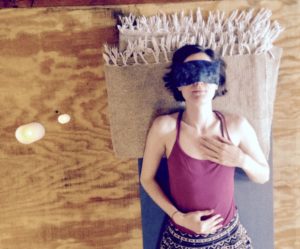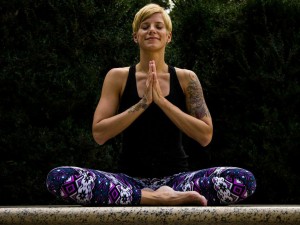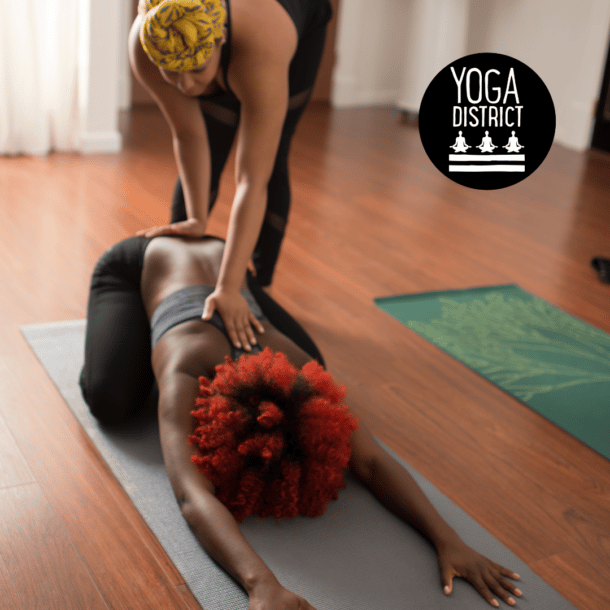
You close your eyes and breathe in the smell of stuffing, mashed potatoes, and freshly baked cookies .
For people celebrating during the holiday season it can be a time of mixed emotions. With this in mind, Yoga District has compiled some mindfulness tips for dealing with holiday stress.
We hope that the following suggestions will guide you through peaceful holidays. You can practice them anytime, anywhere.
In the whirlwind of the holiday, your mind might be stirred by stress, leaving your body feeling tense, your emotions volatile, and your thoughts groundless. Meditative practices have natural self-healing qualities that ground the body and calm the mind.
Please note: Stop any of our mindful suggestions if you become light headed or dizzy. Make sure to practice within your own range of abilities and limits. If you have any medical concerns, please consult with a doctor before practicing.
Breathing Techniques (Pranayama)
Belly (Abdominal) Breathing (1)
Try to breathe six-ten times per minute for five to ten minutes. Can be practiced several times a day
Benefits: Calming mind and body
- Either sit comfortably or lie down on your back.
- Place a hand on your chest with your other hand over the center of your belly.
- Take deep slow breaths in through your nose, inflating the diaphragm (belly) and raising your hand atop it. Your breath should go into your belly, not the chest.
- Tighten your abdominal muscles and then relax them as you exhale through your mouth, letting out the entire breath slowly.
- The hand on your belly should return to its original position.
Equal Breathing (Sama Vritti or Counting Breath) (2)
Change the length of breath to suit your needs (increase to six breaths, stay at four or decrease to two) as long as the inhalations and exhalations are the same length. Continue the breathing for several minutes.
Benefits: Calming mind and body also helps with focus
- 1. Sit comfortably with hips higher than your knees or lie down on your back.
- 2. Close your eyes and notice your natural breath.
- 3. Exhale completely.
- 4. Inhale through your nose for a count of four.
- 5. Hold for a count of four (optional).
- 6. Exhale through your nose for a count of four.
Alternate Nostril Breathing (Nadi Shodhana) (3)
Benefits: Finding balance and centering
Note: If the suggested breath count below doesn’t feel good to you, please adjust the count to fit your body’s wants and needs.
- Find a comfortable seat with your sit-bones on the ground and crown of the head lifted to create a long spine and open heart.
- Use your dominant hand for this practice. We will describe the practice with the right hand as dominant. Left-handed people can do this practice by reversing the hand placement.
- Rest your left palm on your left knee, moving your right hand toward the nose.
- Gently close your right nostril using your right thumb, and slowly inhale through the left nostril for six counts.
- Close your left nostril with your ring finger, pausing for four counts.
- Take your thumb off the right nostril and exhale slowly through the right nostril for 6 counts.
- Close the right nostril with your thumb and then pause again for four counts.
- Repeat starting at step three for five- ten cycles (up to five minutes) with your mind focusing on your inhales and exhales.
- Ease back into normal breathing.
Guided Visualization
The moment you feel anxious or groundless, try a guided visualization technique. To let go of your tension, visualize using your five senses to either focus on the current moment or drift off to a restful place.
Grounding Visualization
 If you seek something to ground you in the moment, then with your eyes open, observe your surroundings using all five senses. For example, if right as you sit down to a holiday dinner you feel overwhelmed, then take a deep breath and while exhaling, observe with each sense:
If you seek something to ground you in the moment, then with your eyes open, observe your surroundings using all five senses. For example, if right as you sit down to a holiday dinner you feel overwhelmed, then take a deep breath and while exhaling, observe with each sense:
See the holiday dinner table
Hear people talking
Smell freshly baked cookies
Feel comforting heat from the kitchen
Taste a sip of refreshing water
Calming Visualization
If you would rather clear your mind, then close your eyes and picture a restful place. For example, imagine standing on the shore of a beach, where you would:
See the sun in sky over the water
Hear the waves crashing against the shore
Smell the seashore
Feel the warm water run over your toes
Taste the salty ocean air
EATING WELL
Eating well is a form of self-care. A healthy diet can help lower anxiety (4).
Yet, it’s not always easy to eat well during the holidays. It’s a challenge since there is an expectation that you will overindulge with food at some point. It might not always be possible to only eat wholesome food.
Try bringing a healthier version of a beloved holiday dish! Try this creamy vegan herb mashed potatoes recipe. Enjoy the rich flavor and fluffy texture of this vegan alternative.
The entire Yoga District community hopes you have a lovely time during the holiday season. We hope you feel empowered to use a breathing technique, visualization method, or healthy food options to cope with the holiday stressors.
Sources:
- Belly (Abdominal) Breathing, https://www.health.harvard.edu/lung-health-and-disease/learning-diaphragmatic-breathing
- Equal Breathing (Sama Vritti), https://www.yogapedia.com/definition/8594/sama-vritti
- Alternate Nostril Breathing (Nadi Shodhana), https://www.health.harvard.edu/heart-health/take-a-breather
- Nutrition and Stress, https://campushealth.unc.edu/health-topics/nutrition/nutrition-and-stress






